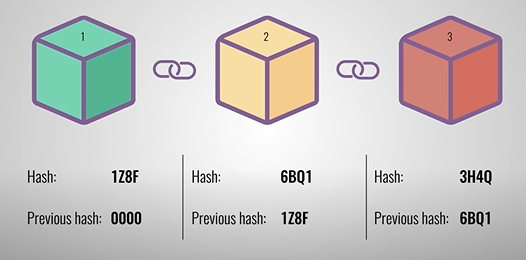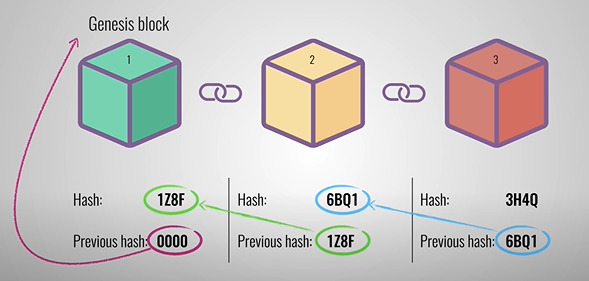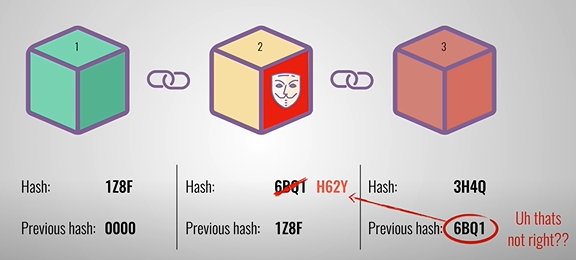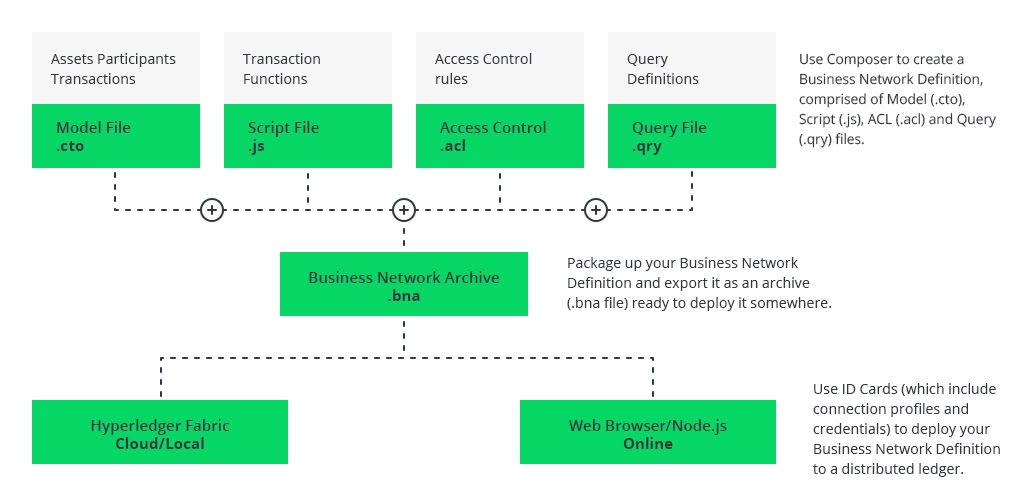Designing a Blockchain Architecture: Types, Use Cases, and Challenges
Blockchains are incredibly popular nowadays. But what is a blockchain? How does a blockchain work, what problems do blockchains solve, and how can blockchains be used? In this article, we explain the blockchain architecture as well as types and components of blockchains.
Main advantages of blockchain technology
Blockchain technology has been widely adopted for the range of benefits it provides. Let’s take a look at the main benefits of blockchain technology:
- Since there’s no central authority to oversee operations, the blockchain is an ideal register for joint business ventures.
- The digital signature and verification process used in blockchains helps prevent fraudulent activity.
- Information isn’t centralized, preventing it from being lost.
What the blockchain is and how it works
Like the name indicates, a blockchain is a chain of blocks that contain information. This technology was originally described in 1991 by a group of researchers and was originally intended to timestamp digital documents so it wouldn’t be possible to backdate or tamper with them.
However, blockchain technology went mostly unused until it was adapted by Satoshi Nakamoto in 2009 to create the digital cryptocurrency Bitcoin.
A blockchain is a distributed ledger that’s completely open to anyone. Blockchains have an interesting property: once data has been recorded inside a blockchain, it’s very difficult to change it. How does that work? Let’s take a close look at a block.
Each block in a blockchain contains some data, the hash of the block itself, and the hash of the previous block. The data stored inside a block depends on the type of blockchain. The Bitcoin blockchain, for example, stores transaction details, such as the sender, receiver, and number of coins.
Each block also has a hash, which you can compare to a fingerprint. A hash identifies the block and all of its contents and is always unique, just as a fingerprint is. Once a block is created, its hash is calculated. Changing anything inside the block will cause the hash to change. In other words, hashes are very useful when you want to detect changes to blocks. If the hash of a block changes, it’s no longer the same block.
The third element inside each block is the hash of the previous block. This effectively creates a chain of blocks, and it’s this technique that makes a blockchain so secure. Let’s look at an example.

Here, we have a chain of three blocks. As you can see, each block contains its own hash and the hash of the previous block. So block number 3 points to block number 2, and block number 2 points to block number 1. Now, the first block is a bit special, as it cannot point to previous blocks because it’s the first. This block is called the genesis block.

Now, let’s say you tamper with the second block. This causes the hash of that block to change. In turn, that will make block 3 and all following blocks invalidbecause block 3 will no longer store a valid hash of the previous block.

So changing a single block will make all the following blocks invalid. But using hashes is not enough to prevent tampering. Modern computers can calculate hundreds of thousands of hashes per second. This means you can effectively tamper with a block and recalculate all the hashes of other blocks to make your blockchain valid again.
To mitigate this possibility, blockchains implement something called proof of work. This is a mechanism that slows down the creation of new blocks. In the case of Bitcoin, it takes about 10 minutes to calculate the required proof of work and add a new block to the chain. This mechanism makes it hard to tamper with blocks because if you tamper with one block, you’ll need to recalculate the proof of work for all the following blocks.
The security of a blockchain comes from its creative use of hashing and the proof of work mechanism. But there’s one more way blockchains secure themselves, and that’s by being distributed. Instead of having a central entity manage the chain, a blockchain uses a P2P network that anyone is allowed to join (assuming the blockchain is public). When someone joins this blockchain network, they become a node and get a full copy of the blockchain. This node can then use the copy of the blockchain to verify that everything is in order.
Now let’s see what happens when a blockchain participant creates a new block. That new block is sent to all nodes on the network. Each node then verifies the block to make sure it hasn’t been tampered with. If everything checks out, each node adds this block to its own blockchain. The nodes in the network eventually arrive at a consensus: they agree on which blocks are valid and which aren’t.
Blocks that have been tampered with will be rejected by other nodes in the network. So to successfully tamper with a blockchain, you need to tamper with all blocks on the chain, redo the proof of work for each block following the block tampered with, and take control of more than 50% of the P2P network. Only then will your tampered block be accepted by everyone else. But this is almost impossible to do.
Key characteristics of the blockchain architecture
The blockchain architecture has many business benefits. Here are some built-in characteristics:
- Cryptography — Blockchain transactions are verified and trustworthy because of complex computations and cryptographic proof between the parties.
- Immutability — Records in a blockchain can’t be modified or deleted.
- Provenance — It’s possible to trace the origin of each transaction in the blockchain ledger.
- Decentralization — Every member of the blockchain structure is able to access the entire distributed database. Unlike in a centralized system, a consensus algorithm is responsible for network management.
- Anonymity — Every member of the blockchain network has a generated address, not a user ID. This preserves the anonymity of users, especially in a public blockchain.
- Transparency — The blockchain system is unlikely to be damaged as it takes enormous computing power to completely rewrite the blockchain network.
Blockchain architecture explained
A blockchain is an open financial ledger or record in which every transaction is authenticated and authorized. A blockchain is designed as a decentralized network of millions of computers, commonly referred to as nodes. It’s a distributed database architecture in which each node plays the role of a network administrator who voluntarily joins the network. Since there’s no centralized information in a blockchain architecture, a blockchain is literally impossible to hack.

The blockchain architecture supports a growing list of ordered records known as blocks. Each block maintains a timestamp and a link to the previous block.
Components of a blockchain architecture
Here are the main components of a blockchain architecture:
- Node — a computer in the blockchain architecture (each node has an independent copy of the entire blockchain ledger)
- Transaction — A data record verified by blockchain participants that serves as an almost immutable confirmation of the authenticity of a financial transaction or contract
- Block — A sealed data compartment that contains: 1) a native hash code that identifies the block, 2) the hash code from the previous block in the sequence of blocks, and 3) a set of timestamped transactions
- Chain — A ordered sequence of blocks
- Miners — Nodes that validate blocks before adding them to the blockchain structure
- Consensus (protocol) — A set of rules and agreements for performing blockchain operations
Types of blockchain architectures
Public blockchain architecture
A public blockchain architecture operates on the basis of proof of work (PoW) consensus algorithms and uses appropriate protocols. A public blockchain doesn’t need any permission, as it’s open-source. You can define new blocks with their existing state, as this is open-source. You can also download a blockchain’s code and check transactions on the network.
This makes transactions possible across the entire network. A public blockchain architecture allows for transparent yet anonymous or pseudonymous transactions. The Bitcoin, Ethereum, and Litecoin blockchains are public.
Private blockchain architecture
A private blockchain architecture allows only a certain group of participants (organizations or people) to access information. Such blockchain architectures are built by organizations with the aim of increasing the overall benefit or efficiency. Their reliability is ensured by the common goals of the participants and proof of stake (PoS) and Byzantine fault tolerance (BFT) consensus algorithms.
A private blockchain architecture decouples the main blockchain protocol from the smart contract layer. Using a private blockchain, you can open up a programmable transaction area commonly called a smart contract as well as online markets.
Consortium blockchain architecture
There’s also a consortium, or public permissioned, blockchain architecture. In this type of blockchain architecture, anyone can connect to and view the blockchain, but a participant can add information or connect a node only with the permission of other participants. Such blockchains are built by organizations in order to increase trust among customers, consumers or society as a whole. Here, reliability is also achieved by the presence of trust between participants and the same PoS and BFT consensus algorithms.
Depending on the type of blockchain structure and its context, a blockchain system can be more centralized or decentralized. This just refers to the design of the blockchain architecture and who controls the ledger. A private blockchain is considered centralized, as it’s controlled by a specific group with increased privacy. In contrast, a public blockchain is open and therefore decentralized.
In a public blockchain, all records are publicly visible and anyone can participate in the agreement process. But this type of blockchain is less efficient, as it takes a significant amount of time for each new record to be accepted in the blockchain architecture.
From an efficiency standpoint, the time required to confirm each transaction on a public blockchain is also not environmentally friendly, as it requires huge processing power compared to a private blockchain architecture.
How to make a private blockchain architecture
Now let’s dive deeper and find out how to make a private blockchain architecture. A decentralized blockchain application is made in the same way as any other conventional software product. Development requires a functional specification, a UI/UX design, and an architectural plan.
It’s imperative to define the application’s functionality, establish user roles, and consider the system flow and interactions between users.
To build your own blockchain architecture, you need to consider:
- the infrastructure of an application hosted in a defined environment within one or more organizations
- the tasks and purposes for which this blockchain solution is being designed
There are several open-source solutions you can use to create a private blockchain architecture.
Creating a blockchain network
As soon as an organization or multiple organizations decide to implement a blockchain solution, they already create a network. The network can be viewed as a company with its own staff, or in terms of the technical infrastructure within these companies.
Let’s consider an example of a blockchain architecture for the production and sale of gold jewelry.
The parties involved in this network include:
- Gold mining companies
- Government institutions
- Gold transporters
- Gold sellers
- Goldsmiths
A blockchain solution can bring together all these parties in a peer-to-peer (P2P) network that eliminates all risks and builds a transparent system. All network participants will have access to synchronized data from the shared, immutable ledger and will be able to track the movement of gold from its extraction to its sale to the end consumer in the form of jewelry. The blockchain ledger will contain the sequence of all activities taking place, for example, mining, processing, and distribution.
Usually, each party in the network keeps its own copy of the blockchain, which is synchronized with the smart protocols and technical layers of the blockchain network.
For multiple users, there’s a membership service provider (MSP) that allows access to specific users on the network.
All transactions along the way are stored in the general ledger (for example, diamond images, data on a diamond’s mining location, color, and serial number, information on the location where a diamond was cut, cleaned, sold, etc.).
Here’s a high-level diagram of a hyperledger architecture for building a blockchain solution.

Creating blockchain code
After the blockchain network is set up, the next step is to agree on the type of business transactions happening inside the blockchain architecture.
Typically, these rules are written in legal agreements. In the blockchain code, these agreements are written in the form of smart contracts (also known as Chaincode or a Business Network Definition in Hyperledger Composer). Just like a traditional contract, a blockchain contract contains participants, assets, and transactions. For every transaction, a transactional processor function is written (in JavaScript) that describes what happens after the transaction is created.
Skills required to build a blockchain architecture
Blockchain development requires profound technical skills. A strong background in computer science or engineering is desirable to work with blockchain architectures. In addition, knowledge of consensus methods, data structures, decentralized ledgers, cryptography and cryptocurrencies, and data security is in high demand.
In the last few years, the process of blockchain development has been simplified by Ethereum and similar blockchain software. Ethereum is an open-source software platform based on blockchain technology that allows you to build and deploy decentralized applications (DApps).
In terms of the programming skills needed to develop a blockchain solution, there are a number of programming languages you need to be familiar with.
To implement a custom blockchain system, you can use programming languages such as C ++, Python, C, Java, and Ruby. In addition, web development skills such as knowledge of HTML, CSS, and Node.js can come in handy.
If you’re interested in writing smart contracts using Ethereum, you’ll need to know Solidity. In addition to complex programming skills, blockchain developers need to understand business requirements and operations and have excellent collaboration and negotiation skills.
Use cases of blockchain technology
Smart contracts
Smart contracts are a way of transparently exchanging value without third parties being involved. A distributed ledger such as a blockchain allows smart contracts to be executed when specified conditions are met. Ethereum is an open-source public blockchain that can leverage smart contracts. With current blockchain technology, smart contracts can be automated using Bitcoin.
Decentralized sharing economy
Thanks to their decentralized networks, blockchains enable peer-to-peer payments, which can ultimately lead to a truly decentralized sharing economy.
Crowdfunding
Crowdfunding is growing in popularity, and blockchain technology is taking this interest to the next level, with the potential to develop crowdsourced venture funds. The Ethereum-based DAO (Decentralized Autonomous Organization) is one example of a crowdfunding project that raised $200 million in two months. Not to mention it was just another form of smart contract.
Transparent management
Transparency is essential when you operate a business, and in this context, blockchain technology is changing the governance landscape. As the blockchain’s distributed database technology enables completely transparent and accessible contracts, organizations are on the verge of making blockchain-based decisions. We can see Ethereum-based smart contracts used to support digital assets or organizational information for data management practices.
Medical records
Blockchains can allow for the standardization of the secure electronic exchange of medical records between healthcare providers, which would be less burdensome than current approaches. Blockchain technology allows for a decentralized records management system that eliminates the need for an organization to manage patients’ access to records. Blockchain-enabled healthcare applications have potential benefits such as the ability to instantly verify the authenticity of prescriptions and automatically detect the possibility of harmful drug interactions.
Supply chain management
When combined with properly validated business practices, a blockchain can serve as a verifiable method for documenting supply chains. For example, this technology can be used to ensure that diamonds are not tied to conflict, to guard against counterfeiting of IoT devices, and to reliably track materials and manufactured products from source to destination, thus promoting ethical practices.
KYC and AML
Know Your Customer (KYC) and Anti-Money Laundering (AML) are two generally accepted practices that can benefit from blockchain technology. Financial institutions currently need to complete an intensive multi-step KYC/AML process for each client, which is costly. If the blockchain were introduced into this process, it could reduce costs by running a KYC/AML check on a given client once and making the results available to all financial institutions while increasing the efficiency of analysis and monitoring.
Quick summary of blockchain architecture
This article has shed light on the blockchain architecture. Here are the key takeaways:
- A blockchain is a distributed ledger that’s completely open to anyone. Once data has been recorded inside a blockchain, it’s very difficult to change it.
- The blockchain architecture supports a growing list of ordered records known as blocks. Each block maintains a timestamp and a link to the previous block.
- You can use a blockchain architecture in smart contracts, crowdfunding, supply chain management, KYC and AML processes, medical records, transparent management, and decentralized sharing economy projects.
- Blockchain developers need a strong background in computer science or engineering to work with blockchain architectures. In addition, knowledge of consensus methods, data structures, decentralized ledgers, cryptography and cryptocurrencies, and data security is in high demand.
- Developing a blockchain architecture requires a functional specification, UI/UX design, and architecture plan. It’s imperative to define the functionality of the application and the roles of users as well as to consider the system flow and interactions between users.
If you want to use a blockchain architecture for your mobile app or if you have any questions regarding this topic, contact Mobindustry for a free consultation.


